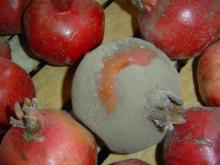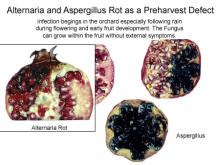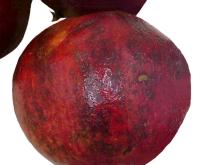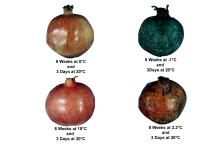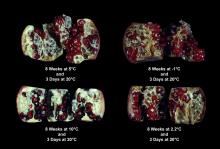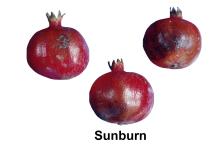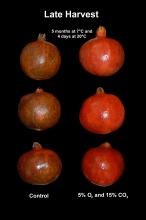Product Description
Indices de Maturité
- Couleur rouge externe (selon les cultivars)
- Couleur rouge du jus (Egale ou plus foncée que la couleur Munsell 5R-5/12 )
- Acidité du jus inférieure à 1,85%
- Indemne des craquelures de croissance, coupures, blessures et pourritures
- Couleur de la peau et la texture lisse
- Saveur dépendant du rapport E/A (Extrait sec soluble/Acidité) qui varie selon les cultivars. Une teneur en extrait sec soluble supérieure à 17% est souhaitable
- Un teneur en tanins inférieure à 0,25% est désirable
Manipulation et stockage post-récolte
5°C (41°F) pour plus de deux mois, le stockage à long terme devra être maintenu à 7,2°C (45°F) pour éviter les dégâts de froid.
90-95%
Les grenades sont très sensibles à la perte en eau entrainant un ramollissement de l’écorce. Le stockage des fruits dans des films plastiques et l’application de la cire peuvent réduire la perte en eau, surtout sous des conditions d’humidité relative faible.
| Températures | 5°C (41°F) | 10°C (50°F) | 20°C (68°F) |
| ml CO2/kg·hr | 2-4 | 4-8 | 8–18 |
Pour calculer la production de chaleur, multiplier ml CO2/kg·hr par 440 pour obtenir le Btu/ tonne/jour ou par 122 pour obtenir le kcal/tonne/jour.
Moins de 0,1 µl/kg·hr à 10°C (50°F)
Moins de 0,2 µl/kg·hr à 20°C (68°F)
L’exposition des fruits à des concentrations d’éthylène supérieures ou égales à 1 ppm stimule la respiration et le taux de production d’éthylène, sans affecter les composantes de qualité interne. Les grenades ne mûrissent pas après récolte ce qui exige leur cueillette à la maturité totale pour garantir la meilleure qualité gustative.
Très peu d'études ont été conduites sur la réponse des grenades à l’AC. Le stockage à 2% O2 réduit les dégâts de froid des grenades si elles sont maintenues à une température inférieure à 5°C (41°F). Dans une étude, des grenades ont été bien conservées à 6°C (43°F), sous une composition de 3% O2 + 6% CO2, pendant 6 mois. Dans une autre étude, une combinaison de 5% O2 + 15% CO2 s’est montrée efficace dans le contrôle des pourritures et de l’échaudure pour plus de 5 mois à 7°C (45°F).
Physiological and Physical Disorders
Dégâts de froid. Les symptômes externes se manifestent sous forme de décoloration brunâtre de la peau et l’augmentation de la susceptibilité aux pourritures. Quant aux symptômes internes, ils se présentent sous forme de couleur pâle des graines (pulpe autour du noyau) et une décoloration brunes des cloisons blanches qui séparent les loges surlequelles sont fixées les graines. Les dégâts de froid se produisent si les grenades sont exposées pendant plus d'un mois à des températures comprises entre le point de congélation -3°C (26,6°F) et 5°C (41°F), ou conservées à 5°C (41°F) pour plus de deux mois.
Echaudure de l’écorce. Décoloration brune de la peau (sans symptômes sur les graines ou les tissus environnants) apparaît pendant le stockage de plus de trois mois à 7°C (45°F) ou à des températures plus basses).
Désordres
Pourriture du cœur du fruit. Elle peut être causée par Aspergillusspp et Alternaria spp. Les fruits affectés montrent une légère coloration anormale de la peau et une masse des graines noircies à l’intérieur. La maladie se développe lorsque le fruit est sur l’arbre. Les grenades affectées peuvent être remarquées et écartées par les trieurs au niveau de la station de conditionnement.
References
Des références provenant de sources scientifiquement validées seront ajoutées ultérieurement.







